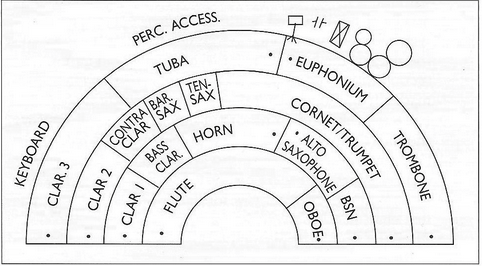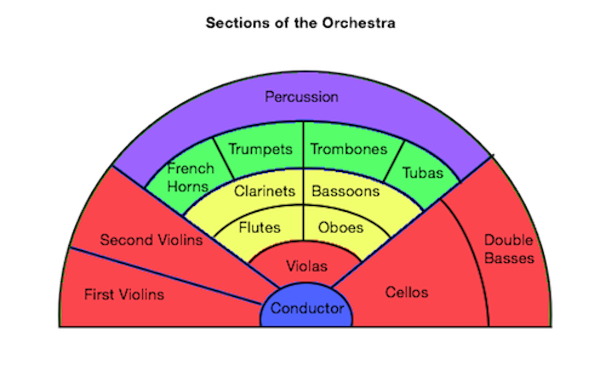Designing/Staging of the Marching Battery Percussion
I covered this subject in part in my blog entries, “Doug’s Helpful Hints for Visual Design: Spacing” and “Doug’s Helpful Hints for Visual Design: The Rest”. This time I’m going to take a slightly different approach. Rather than a quick and dirty list of guidelines, this will be a more in depth discussion. Everything discussed here assumes the visual designer has been supplied with a detailed percussion score. Here. We. Go.
The Battery percussion section in marching groups serves as the Timekeeper or “Pulse Engine” for the entire ensemble 80% or more of the time. Of course this depends upon the scoring of the music being performed. Because of this, the Battery needs to be centrally located in relation to the rest of the ensemble (Winds and Front Ensemble). This central location not only takes into account side to side (usually between the 35s), but also front to back orientation (usually in front of the back hash mark). The greater the distance, the more challenging the task of timekeeping.
When thinking about placement of the Battery, visualize concert bands, jazz bands, and orchestras you’ve seen/heard on stage. Where is the percussion section and/or drummer located? That’s right, in the back so their sound is coming through the rest of the ensemble.
In the marching activity, we get our time or pulse reference from behind us. To quote Clif Walker, “Golden Rule/Marching Band Commandment #1: You can NEVER listen forward, towards the audience, for time.” If the Battery is the Pulse Reference, it needs to be behind the rest of the ensemble that it is providing time for. Now, given there are contemporary wind ensembles who have moved the percussion section forward and many times to one side of the concert stage. This provides a different type of energy, but maintaining cohesive time in an ensemble on the concert stage and a football field are 2 very different things. The visual designer must also consider line of sight. While it is best to keep the Battery behind the winds, putting them directly behind Sousaphones/Tubas and or large spinning or stationary props will be a hindrance as the members of the battery may not be able to see a conductor/drum major.
Does this mean the visual designer can’t have the Battery percussion staged in front or to one side of the winds and not playing through them? No. But, a skilled visual designer will know when and why this type of variation from the norm is needed to help the full ensemble achieve its musical/visual performance goals. More on this later.
When the Battery isn’t playing, there is much more freedom/flexibility with its placement on the field. To quote Clif Walker again, “The Before I Play Consideration: If a section of the Battery rests for 8 measures, then plays, it is important to consider what they are listening to/using for pulse during that down time so they are prepared for a successful start to their (next) playing phrase. They could do cartwheels for 8 measures, as long as a timing voice is staged backfield of them to use before they play.” So this is the time for the visual designer to vary from the norm. This is a universal principal also applied to Wind sections. Pulse Reference comes from behind the performer.
For another great reference for timekeeping/marching band physics and percussion staging, view Bill Bachman’s Video.
I’m pretty sure there isn’t anyone reading this who has watched DCI, BOA, WGI, etc. who doesn’t really enjoy the energy of seeing the hands/sticks of the Battery section in action. This brings us to another consideration when designing for or staging the Battery percussion section. Clif Walker calls it, the “Visibility Bubble”. Even when the Battery is say, in the middle of the middle 3rd of the football field, providing an open space of 8 or more steps in front of the Battery will allow the audience to sample what the performers are doing to produce sound on their instruments.
A second way to provide Battery Visibility is to use contrary motion with the Battery. When the Winds or Color Guard are moving Left, move the Battery to the Right or visa versa. The same can be said about moving toward or away from the front sideline. Using contrary motion will provide needed contrast and help the audience focus on a particular segment of the ensemble.
Probably the most popular yet troublesome option for providing Battery visibility is by clearing out the other segments and bringing the Battery forward and in front of the remainder of the ensemble. This can work if the visual designer is clever and provided the music scoring lends itself to this option. Remember the “Golden Rule/Marching Band Commandment #1: You can NEVER listen forward, towards the audience, for time.” So, let’s say there is an extended amount of time the Battery is playing either by itself or with only the Front Ensemble (probably 64 or more counts), the designer may opt to bring them forward. However, it will be very important that the Winds be back in front before their next entrance in order to avoid major timing challenges. For musical segments that are shorter, the designer can actually use the “Visibility Bubble” by moving the entire ensemble forward and allowing a little greater distance between the Battery and other segments of the ensemble. The designer can then use the Winds and Color Guard to provide focus, directing the audience toward the Battery visually.
Visual designers may find it challenging to be creative when designing for the Battery percussion. They may feel hampered/limited by that “Golden Rule/Marching Band Commandment #1”, but there are ways of approaching the Battery that can allow for freedom and creativity. Overall, thinking of the Battery as a separate visual/musical element of the ensemble can allow for freedom. The designer can be creative with the individual members of the Battery and their movement. By moving the individual instrument groups of the Battery around within the section itself, the designer can create great interest and keep the performers engaged. The use of Follow the Leader, Pinwheels, Pass Throughs, etc. can all be effective. Then the designer can include the Battery as a part of the ensemble as a whole at key full ensemble moments throughout the production.
This brings me to the Listening Environment. I would define Listening Environment as the physical arrangement of performers and its impact on what the performers (and the individual) are able to hear in regards to timing, pitch, blend, balance, etc. The designer will need to have a clear image of the performance level/experience of the Battery section in order to know how many different Listening Environments or variations to use during the entirety of a show. The beginning level Battery should maybe only experience 2 or 3 different Listening Environments during a show, while a very advanced section could handle 10 or more.
As a general rule, the Bass Drums are in the rear of the Battery section and very seldom ever in front. Again, the designer must have a reason to vary from the norm. The individual instrument groups are also VERY rarely ever divided. The Snares are always together, the Tenors are always together, etc. But, there may be a time when the music allows for some mixing to create visual interest and/or allow for some creative re-staging of the section. If the section is playing a unison rhythm, that may be a good time to use that staging approach.
The second general rule is that stacked lines (Line 1 = Tenors, Snares, and Cymbals, Line 2 = Bass Drums), Concave Arcs/Chevrons work best for the Battery section to hear and match each other. Vertical alignment or Convex Forms will create unnecessary challenges. The use of a long single horizontal line while it looks very clean and like a company front, will also create unnecessary challenges in the Listening Environment. The wider the line, the more challenging. Use caution.
Finally, the visual designer has to be cautious. As the Battery percussion section goes, the rest of the ensemble usually goes. Because of the Timekeeping responsibilities of the Battery, it usually has to lead and be ahead of the rest of the ensemble in regards to music preparation. Anything that inhibits that preparation and order of things will derail the entire ensemble. The visual designer has to do everything within their power to make the ensemble successful no matter the level of performers, experience, or time allowed for rehearsal. How a visual designer manages the design for the Battery is paramount to that end.
I love hearing from readers like you. Please leave a comment and/or share this blog with a friend!—DB




